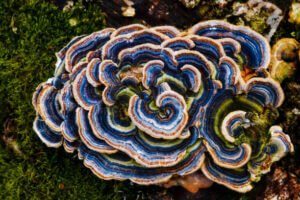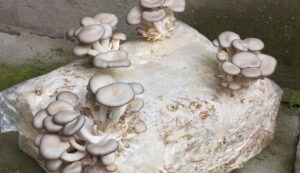
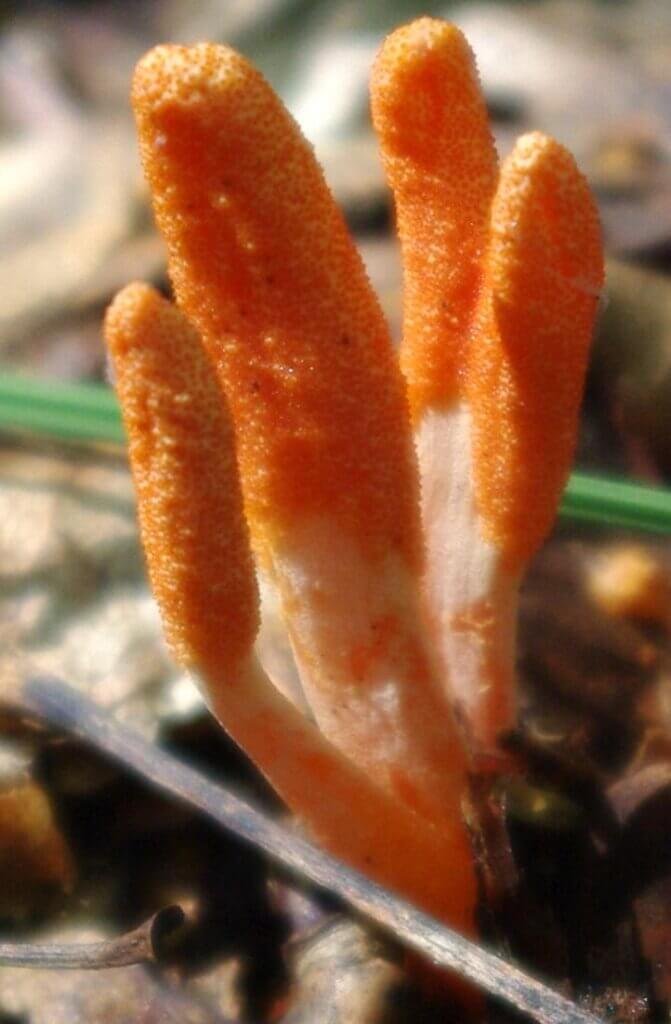
Cordyceps mushrooms are a fascinating group of fungi that have a unique and complex life cycle. They are parasitic on insects and other arthropods, and can manipulate their behavior and movement to serve their own reproductive needs. They are also known for their medicinal properties and have been used in traditional Chinese medicine for centuries.
There are over 400 species of cordyceps, each one specialized to infect a specific host. Some of the most well-known and widely studied species are Cordyceps sinensis and Cordyceps militaris. These two species are the main types of cordyceps that are used in herbal medicine. They have been shown to have various health benefits, such as improving energy, stamina, immunity, respiration, and libido.
Cordyceps mushroom life cycle
One of the most well-known examples of cordyceps is Ophiocordyceps unilateralis, which infects carpenter ants in tropical forests. This fungus has a complex life cycle that involves manipulating the ant’s muscles, nervous system, and immune system to achieve its goals.
Here is how it works:
The fungus infects the ant through spores that attach and penetrate the exoskeleton. The spores then grow into fungal cells that spread throughout the ant’s body, consuming its tissues and organs.
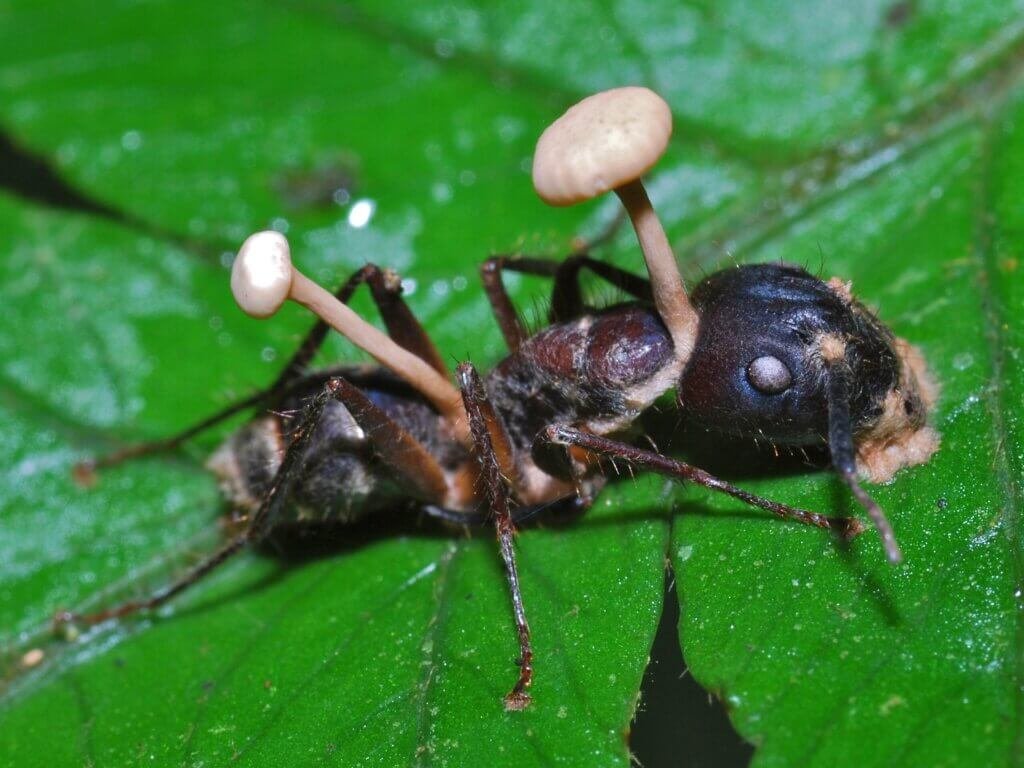
The fungus does not kill the ant immediately, but waits for the right environmental conditions, such as temperature and humidity, to trigger the behavioral changes. The fungus also produces chemicals that suppress the ant’s immune system and prevent other fungi from competing with it.
The fungus does not actually control the ant’s brain, as previously thought. Instead, it manipulates the ant’s muscles by growing into them and releasing chemicals that cause contractions. The ant’s brain remains intact and functional, but it cannot override the signals from the fungus.
The fungus makes the ant climb to a specific height, sink its jaws into a leaf vein on the north side of a plant, and wait for death before sprouting a spore-producing stalk from its head. This ensures that the spores can disperse over a wide area and infect more ants. The fungus also coats the ant’s body with a sticky substance that prevents it from falling off the leaf or twig.
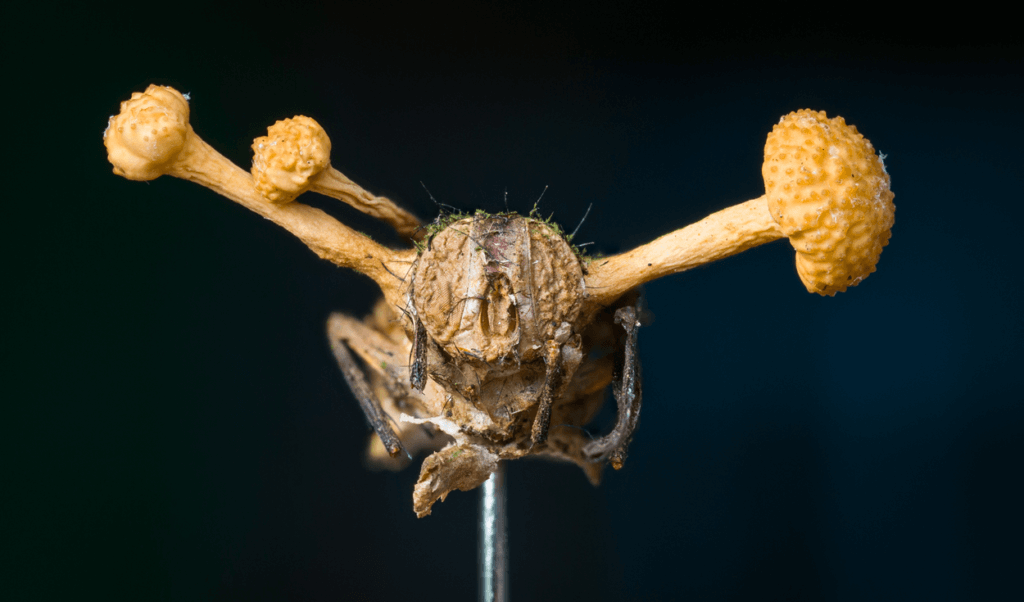
Types of Cordyceps
Ophiocordyceps unilateralis:
Ophiocordyceps unilateralis made news in 2008 after a BBC Planet Earth film showed a time-lapse of the fungus taking over an ant’s body.
This unique fungus inspired the imaginary zombie mythos behind The Last of Us computer game and TV program. It’s also been a focal point of continuing study into how cordyceps develop and spread in general.
Ophiocordyceps was regarded as a member of the cordyceps family as a whole until 2007. However, due to its deeper coloration, it is currently regarded as belonging to a different family of fungi. It still works in a similar manner to other cordyceps, but it particularly targets carpenter ants in temperate woods in South Carolina, Florida, and Japan, as well as tropical forests in Brazil, Australia, and Thailand.
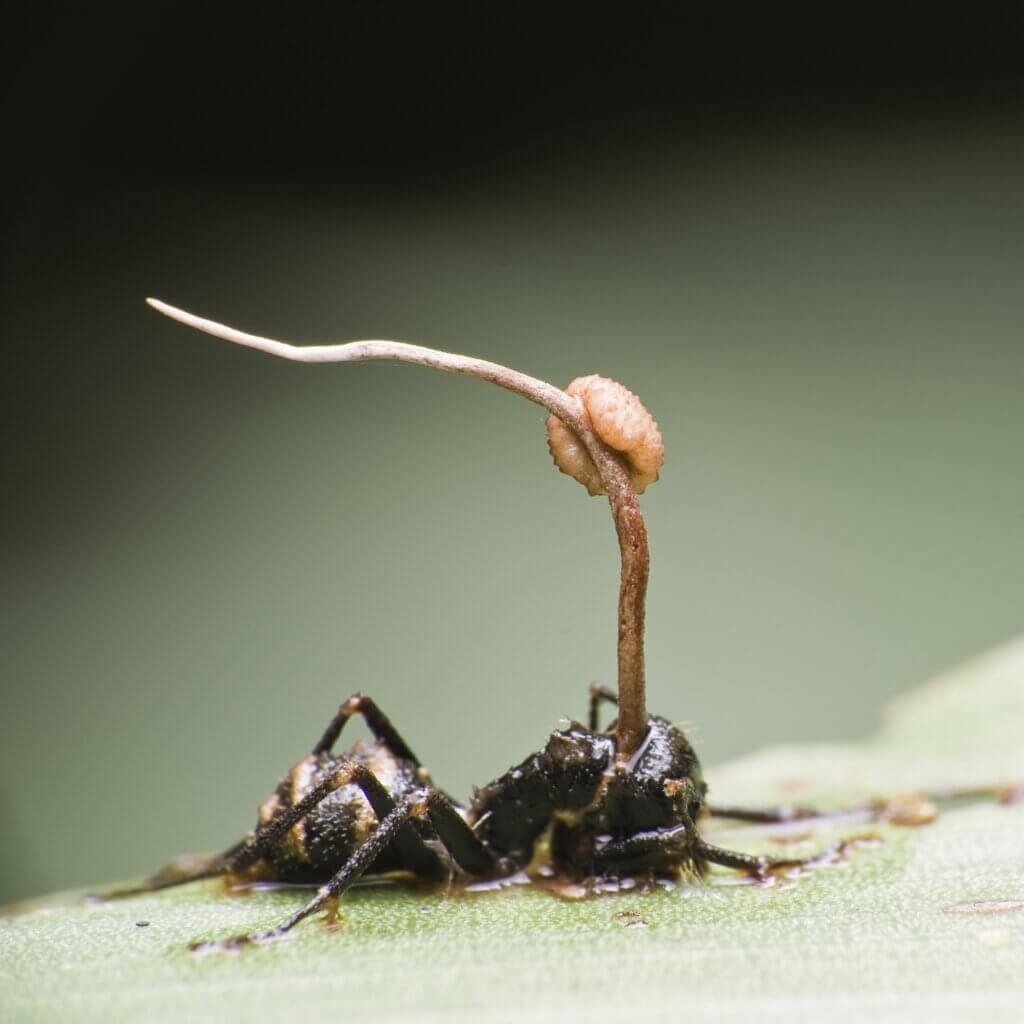

Cordyceps Sinensis:
Cordyceps sinensis, also known as the caterpillar fungus, is one of the most expensive natural commodities in the world. It grows exclusively on the larvae of ghost moths in the high mountains of Tibet, Nepal, and India. It is very difficult to harvest and cultivate, and it can cost up to $50,000 per pound.
It is the most famous and sought-after species of cordyceps. It is traditionally used in Chinese medicine for its potential anti-inflammatory, immune-boosting, and energy-enhancing properties.

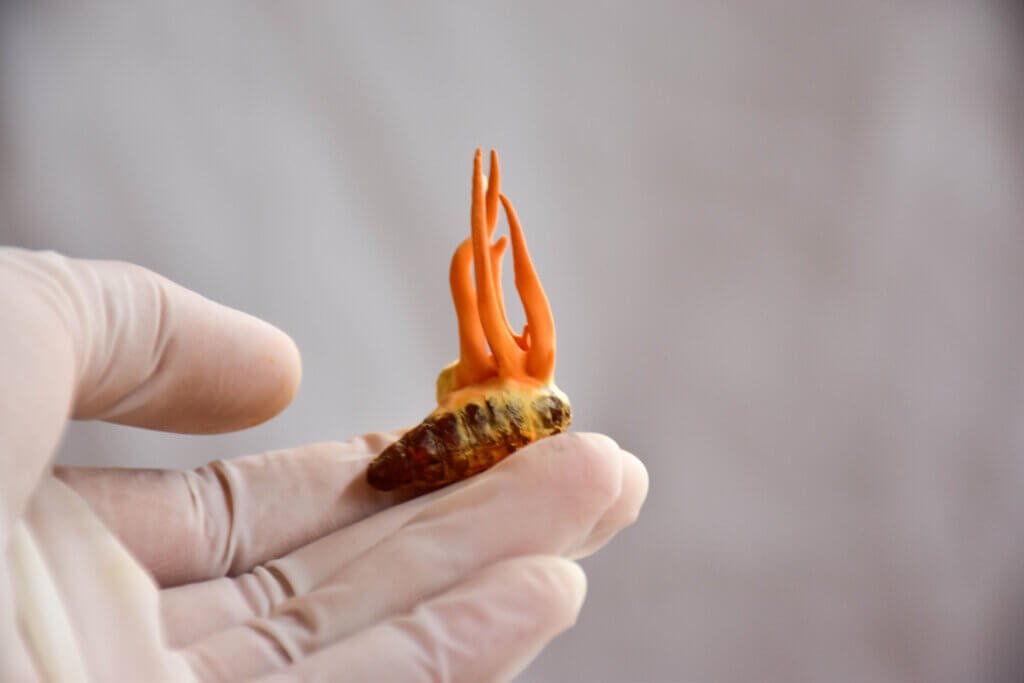
Cordyceps Militaris:
This species is commonly cultivated and used as a substitute for the rare and expensive Cordyceps sinensis. It is known for its potential antioxidant, anti-inflammatory, and antimicrobial properties. It has a bright orange color and grows from the head or body of various insects.
The Medicinal Properties for Cordyceps mushroom
1- Energy and endurance boost
Improve Athletic Performance
Cordyceps may aid athletes because it has been shown to increase energy levels. A recent clinical study discovered that cordyceps users had increased levels of adenosine triphosphate (ATP) and inorganic phosphate. These are two essential components of the body’s energy generation.
Despite its intricacy, experts believe that cordyceps increases performance via improving energy generation. ATP is a chemical that assists cells in functioning and generates energy. This advantage is especially essential for athletes seeking a long-lasting source of energy since it delivers a consistent flow of power that does not result in a “crash” like a sugar high. Mice given cordyceps supplements, for example, demonstrated an 18.4% increase in liver ATP levels.
Boosting Oxygenation
Cordyceps has been found to increase the efficiency of oxygen utilization and oxygen uptake in the body. It may enhance the oxygen-carrying capacity of red blood cells and improve blood circulation, resulting in better oxygen delivery to the muscles and organs, ultimately increasing VO2 max (maximum oxygen consumption).
Regulating Inflammation and Oxidative Stress
Cordyceps possesses anti-inflammatory and antioxidant properties. By reducing inflammation and oxidative stress in the body, it may help optimize oxygen uptake and utilization, thus improving VO2 and overall endurance.
Enhancing Mitochondrial Function
Cordyceps has been found to boost mitochondrial function in cells. Mitochondria are the powerhouse of our cells, responsible for energy production. By enhancing mitochondrial function, cordyceps may improve the efficiency of oxygen consumption and utilization, resulting in increased VO2 and oxygen intake.
2- Respiratory health
Cordyceps has been traditionally used to treat respiratory conditions such as chronic bronchitis, asthma, and cough. It is believed to have bronchodilatory and anti-inflammatory effects, helping to improve lung function.
Research suggests that cordyceps can improve the oxygen uptake of lung cells, enhance respiratory muscle function, and reduce inflammation in the airways. These effects can potentially benefit individuals with conditions such as asthma, chronic obstructive pulmonary disease (COPD), bronchitis, and pneumonia.
3- Anti-Aging Properties
There is some evidence to suggest that Cordyceps mushrooms may have anti-aging properties. Cordyceps contains various bioactive compounds such as antioxidants, polysaccharides, and cordycepin, which may contribute to its potential anti-aging effects.
Antioxidants help combat oxidative stress and damage caused by free radicals, which can contribute to aging and cellular damage. Cordyceps mushrooms have been found to possess potent antioxidant activity, helping to neutralize harmful free radicals and protect cells from damage.
Polysaccharides, another component found in Cordyceps, have been shown to have immune-modulating effects. A strong immune system plays a critical role in maintaining overall health and may have an impact on slowing down the aging process.
Cordycepin, a nucleoside compound present in Cordyceps, has been found to have various beneficial effects on cellular function and longevity. It has been shown to enhance mitochondrial function, which is crucial for energy production and overall cellular health. Improved mitochondrial function is thought to have anti-aging effects by reducing oxidative stress and promoting cellular repair.
4- Potential Anti-Tumor Effects
Cordyceps mushroom has shown potential anti-tumor effects through its ability to stimulate the immune system and inhibit the growth of cancer cells. Studies have demonstrated that Cordyceps can enhance the activity of natural killer cells, which play a crucial role in recognizing and destroying cancer cells. Additionally, it has been found to possess anti-inflammatory and antioxidant properties, which can help reduce tumor growth and prevent DNA damage that may lead to cancer development.
In one trial, cordyceps was used to cure rats who had leukopenia following radiation therapy and treatments with the chemotherapeutic medication Taxol.
The leukopenia was interestingly reversed by cordyceps. These findings imply that the fungus could assist in lowering the side effects of various cancer therapies.
It’s crucial to remember that these experiments weren’t done on people; instead, they were done on animals and in test tubes.
5- Anti-Diabetic Properties
several mechanisms. First, cordyceps mushroom has been found to have anti-diabetic properties. It can help lower blood sugar levels by increasing insulin sensitivity, which allows the body to use insulin more effectively and better regulate blood glucose levels.
Second, cordyceps mushroom has been shown to have antioxidant and anti-inflammatory effects. High levels of oxidative stress and chronic inflammation are often associated with the development and progression of type 2 diabetes. The antioxidants present in cordyceps mushroom can help reduce oxidative stress and inflammation, thereby improving insulin sensitivity and glycemic control.
Additionally, cordyceps mushroom has been found to have a positive impact on lipid metabolism. It can help lower LDL cholesterol and triglyceride levels, which are often elevated in individuals with type 2 diabetes. By improving lipid profiles, cordyceps mushroom can reduce the risk of cardiovascular complications associated with diabetes.
Furthermore, cordyceps mushroom has been reported to enhance physical endurance and energy production. Regular physical activity is crucial for managing type 2 diabetes as it helps in regulating blood sugar levels and improving insulin sensitivity. The increased stamina provided by cordyceps mushroom may encourage individuals to engage in regular exercise, which can have long-term benefits for diabetes management.
6- Enhancing cardiovascular health
Cordyceps mushrooms have long been recognized for their potential to enhance cardiovascular health. These unique and powerful fungi possess a variety of beneficial compounds that promote heart health and aid in maintaining a strong cardiovascular system.
One of the key components of Cordyceps mushrooms is adenosine, a naturally occurring nucleoside that plays a crucial role in regulating blood flow and reducing inflammation. Adenosine helps dilate blood vessels, improving circulation and lowering blood pressure. This, in turn, reduces the strain on the heart and decreases the risk of cardiovascular diseases such as hypertension and atherosclerosis.
Regular consumption of Cordyceps mushrooms has been associated with improved lipid profiles, including decreased levels of total cholesterol, LDL cholesterol, and triglycerides, while increasing HDL cholesterol, also known as “good” cholesterol. Maintaining a healthy lipid profile is crucial for reducing the risk of heart disease and promoting overall cardiovascular well-being.
7- effective tonics and aphrodisiacs
The mushroom is renowned as ‘Himalayan Viagra ‘ for having been used for about 1000 years as an aphrodisiac or as a treatment for hyposexuality. The potential aphrodisiac qualities of Cordyceps mushrooms are often associated with increased energy and vitality, which in turn may have a positive impact on sexual performance and libido. However, it is important to note that the scientific research in this area is still ongoing and that more evidence is needed to validate these claims.

Traditional Uses for Cordyceps mushrooms
Cordyceps mushrooms were also extensively used in Tibet and Nepal as a medicinal remedy. They were employed to address a wide range of health conditions. Traditional uses for Cordyceps mushrooms were not limited to medicinal purposes; they extended into culinary traditions as well. In some cultures, Cordyceps were used as a culinary ingredient in soups, stews, and teas, not only for their potential health benefits but also for their distinct taste and aroma.
Modern Applications and today's uses
Today, Cordyceps mushrooms are still used for these same purposes, as well as for treating other conditions like liver disease, kidney disease, and cancer. While research on the efficacy of Cordyceps mushrooms is ongoing, many people have reported positive effects from incorporating them into their wellness routine.
There are several ways to use Cordyceps mushrooms depending on your preference and the form in which you have them. Here are some common methods:
- Capsules or Pills: Cordyceps mushrooms are available in capsule or pill form. Follow the recommended dosage instructions provided on the product packaging. Typically, it is recommended to take 1-2 capsules per day with meals.
- Powder: Cordyceps mushrooms can be found in powdered form, which is versatile and can be added to various foods and drinks. Here’s how to use the powder:
– Add a teaspoon or desired amount to your smoothies, shakes, or protein drinks.
– Mix it into your coffee, tea, or hot chocolate.
– Sprinkle it over soups, stews, or any cooked dish. - Tincture: Cordyceps tincture is another common form of consumption. It is a concentrated liquid extract that can be taken orally. Follow the instructions provided on the product for the appropriate dosage.
- Cooking: You can also cook Cordyceps mushrooms in various dishes. Here’s how:
– Add sliced or chopped Cordyceps to stir-fries, soups, or sautéed vegetables.
– Use it in pasta sauces, curries, or stews.
– Incorporate it into your favorite recipes that call for mushrooms.




